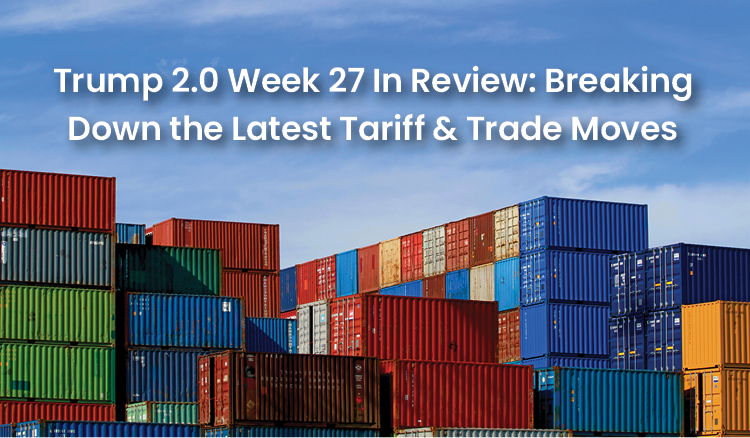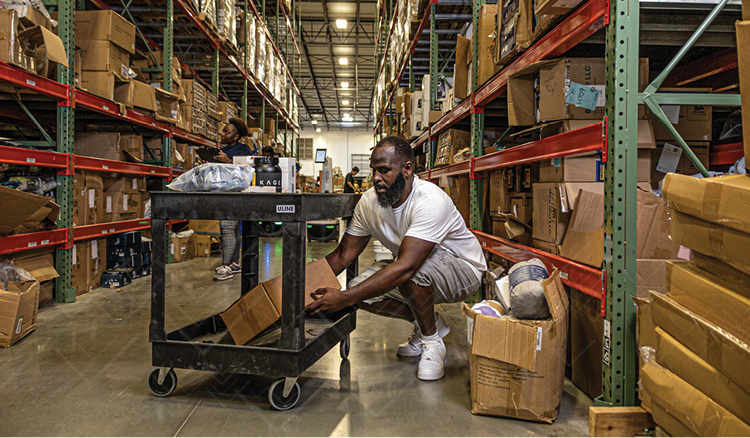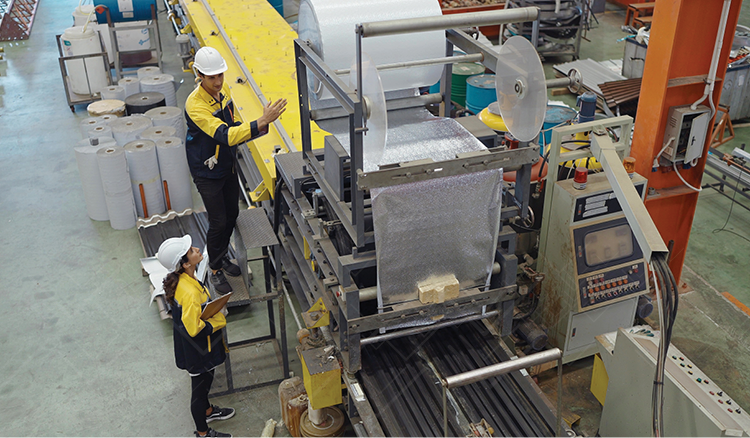Trump 2.0 Week 27 In Review: New Trade Deals with Japan & Indonesia, Stalled Talks with Canada & India, and Tense Negotiations with the EU
It’s been a pivotal week in global trade, with major deals and shifting policies creating fresh momentum—and new challenges—for U.S. manufacturers and distributors. With landmark agreements, tariff hikes, and unresolved disputes with key partners, the global trade landscape is becoming increasingly high-stakes. For American manufacturers and distributors, these developments signal both expanding opportunities and the urgent need for adaptability.
If you haven’t been able to track every update, we’ve got you covered. Below, we break down the most important developments and what they mean for your business:
- A landmark U.S.-Japan trade agreement and $550B investment package
- New market access opened through a U.S.-Philippines trade deal
- Canada lowers expectations for a deal by August
- Stalled talks with India ahead of the August 1 deadline
- AstraZeneca’s $50B reshoring commitment to U.S. manufacturing
- Trump’s proposed 15% tariff compromise with the EU
- New 15–50% baseline tariff structure for U.S. trade policy
- Australia lifts its two-decade ban on U.S. beef imports
Plus: Why operational agility is now mission-critical—and how Veryable helps you stay ready for what’s next.
Trump Strikes Trade Deal With Japan
On Tuesday, President Trump announced a trade deal with Japan, which reduces tariffs on Japanese auto imports from 27.5% to 15% and lowers duties on other Japanese goods from 25% to 15%. In exchange, Japan will deliver a $550 billion investment and loan package aimed at supporting U.S.-bound projects, with a focus on bolstering supply chains in critical industries like semiconductors and pharmaceuticals.
Japan will also make major direct purchases, including:
- 100 Boeing jets
- $17 billion annually in U.S. defense contracts (up ~21% from $14 billion)
- A 75% increase in U.S. rice imports, alongside broader agricultural commitments
These moves are expected to generate significant growth across aerospace, defense, agriculture, and high-tech manufacturing sectors.
The deal also removes redundant safety testing requirements for U.S.-made vehicles, streamlining regulatory approvals and boosting access to the Japanese auto market.
While the American Automotive Policy Council—representing GM, Ford, and Stellantis—initially voiced concerns that the lower tariff for Japanese imports could put U.S.-built vehicles at a disadvantage, Commerce Secretary Howard Lutnick pushed back on this criticism. He stated that U.S. auto CEOs are “cool with” the deal and emphasized that domestic automakers can avoid tariffs altogether by shifting more production back to the U.S.
Still, the overall agreement is being viewed as a net win for U.S. manufacturing. With reduced trade friction, expanded export opportunities, and a major influx of foreign investment, the deal is expected to boost job creation, modernize U.S. production, and strengthen long-term economic resilience.
New Philippines Trade Deal Opens Market Access For U.S. Goods
Also on Tuesday, President Trump announced a new trade deal with the Philippines, establishing a 19% tariff on Philippine imports while granting duty-free access to American goods. The agreement is aimed at reducing the $5 billion U.S. trade deficit and deepening economic ties between the two allies.
As part of the deal, the Philippines will lower or remove tariffs on key U.S. exports—including automobiles, soy, wheat, and pharmaceuticals—creating new opportunities for American producers across multiple sectors. Philippine President Ferdinand Marcos Jr. hailed the agreement as a “significant achievement,” reflecting a shift toward stronger trade and defense alignment with the U.S.
The move also positions the Philippines to remain competitive with regional neighbors like Indonesia and Vietnam, who have recently struck similar deals with the U.S. For American manufacturers and farmers, this agreement opens the door to a growing Southeast Asian market, supporting export growth, industrial expansion, and job creation at home.
Canada Adjusts Expectations on U.S. Trade Deal Amid Tariff Threats
With the August 1 deadline approaching, Canadian Prime Minister Mark Carney and provincial leaders have tempered expectations for a new trade deal with the U.S. Carney stressed that securing a fair, long-term agreement takes precedence over speed.
If talks stall, the U.S. is prepared to impose tariffs of up to 35% on non-compliant Canadian imports—impacting key sectors like steel, aluminum, automotive, and lumber. While this creates near-term uncertainty, it also opens the door for U.S. manufacturers to strengthen domestic supply chains and capture a greater share of North American production.
Meanwhile, Canadian leaders are preparing contingency plans to mitigate tariff impacts, focusing on domestic infrastructure investments, easing internal trade barriers, and encouraging local purchasing.
For U.S. business leaders, these developments underscore ongoing trade uncertainties and the need to monitor supply chain exposure and tariff risks.
U.S.-India Trade Talks Stall Ahead of August 1 Tariff Deadline
Prospects for an interim trade deal between the U.S. and India before the August 1 deadline have dimmed as negotiations remain deadlocked over tariff reductions on sensitive agricultural and dairy products. After five rounds of talks, India continues to resist opening politically critical sectors like agriculture and dairy, which are key to domestic economic stability and voter support. Meanwhile, the U.S. is pressing India for relief from its higher tariffs on steel, aluminum, and automobiles, sectors where American exporters seek better access.
President Trump previously threatened a 26% tariff on Indian imports but delayed enforcement to allow negotiations. Unlike over 20 other countries, India has yet to receive a formal tariff notice. Both sides are exploring deferring some contentious issues to later stages, potentially enabling an interim agreement. However, the complexity of disputes makes a deal by August 1 increasingly unlikely.
Despite the stalemate, officials from both countries remain cautiously optimistic about finalizing a broader trade agreement by September or October, in line with commitments made by Prime Minister Narendra Modi and President Trump earlier this year. Either way, businesses with supply chain exposure to India should monitor developments closely as talks continue.
Australia to Lift Ban on U.S. Beef Imports, Expanding Export Opportunities for American Businesses
On Tuesday, Australia announced it will lift longstanding restrictions on U.S. beef imports, marking a major win for American agricultural exporters and supply chains. The ban, in place since 2003 due to mad cow disease and strict biosecurity rules, had effectively blocked U.S. beef despite the country’s global production strength.
Although partially eased in 2019, ongoing restrictions on cattle from Mexico and Canada—key U.S. trade partners—had kept most American beef out. Now, after a decade-long review and improvements in U.S. cattle tracing and safety protocols, Australia has deemed U.S. beef eligible for import.
The move opens lucrative new opportunities for U.S. beef producers, processors, and distributors, while also boosting demand in supporting sectors like packaging, logistics, and cold-chain management.
Agriculture Secretary Brooke Rollins called it a chance to “put American farmers back in the game,” while Australia’s Agriculture Minister Julie Collins emphasized the science-based nature of the decision. Despite some political pushback in Australia, the removal of these barriers strengthens U.S.-Australia trade ties and gives U.S. exporters another premium global market.
15% Tariff Proposal Signals Hope for U.S.- EU Deal
With the August 1 tariff deadline fast approaching, U.S.-EU trade negotiations have entered a high-stakes phase. Hopes rose this week after EU diplomats indicated that the U.S. is proposing a broad 15% tariff on most European imports as a potential compromise. While that rate would more than triple the current 4.8% average, European officials see it as a manageable alternative to President Trump’s looming 30% blanket tariff—and believe a deal may be “within reach.”
However, The U.S. plans to keep its 50% tariff on EU steel, underscoring its commitment to protecting domestic industries—a key sticking point as European manufacturers grapple with economic headwinds and softening demand.
In the absence of a deal, the EU has already approved a €93 billion package of retaliatory tariffs, set to take effect August 7. These countermeasures target U.S. products including bourbon, cars, chemicals, and aircraft components—and could escalate further to include digital services and intellectual property restrictions if tensions intensify.
For U.S. manufacturers and distributors, the moment carries real risk—but also rare opportunity. A negotiated agreement could expand access to European markets, reduce regulatory friction, and enhance competitiveness. But failure to reach a deal could trigger immediate challenges including supply chain disruptions, higher input costs, and retaliatory barriers. With only days remaining, businesses should be preparing for both scenarios.
U.S. Establishes New Baseline Tariff Range Amid Trade Policy Shifts
On Wednesday, President Trump announced a new baseline tariff range of 15% to 50% for U.S. trading partners, replacing the previous 10% tariff introduced in April. The higher end of the range is reserved for countries with whom negotiations have been more challenging or where the administration perceives unfair trade practices.
Speaking at an AI summit in Washington, D.C., Trump emphasized the simplicity and firmness of the new tariff structure, stating, “We'll have a straight, simple tariff of anywhere between 15% and 50%.” This marks a significant shift in U.S. trade policy, aiming to establish clearer and more reciprocal terms with foreign trading partners.
The announcement reflects the administration’s ongoing efforts to recalibrate trade relationships, encourage fairer market access for American goods, and protect key domestic industries from unfair competition.
AstraZeneca Announces $50 Billion U.S. Investment Amid Tariff Threats
In response to potential tariffs on imported pharmaceuticals, AstraZeneca is making a bold $50 billion investment in U.S. manufacturing and innovation through 2030. Central to this plan is a state-of-the-art drug substance manufacturing facility in Virginia—AZ’s largest and most advanced plant to date—that will produce critical therapies in weight management, metabolic, cardiovascular, and other key areas.
This significant investment underscores AstraZeneca’s commitment to the U.S. market, which already accounts for 42% of its $54 billion annual revenue. The Virginia deal, finalized in a record 33 days, includes a $4 billion state investment, with additional expansions planned at research and production sites in Maryland, Massachusetts, Indiana, Texas, and California. These efforts will drive job creation, bolster high-skilled manufacturing, and strengthen America’s position as a global leader in pharmaceutical innovation.
AstraZeneca’s move is part of a growing wave of reshoring by leading pharma companies—including Roche, Johnson & Johnson, Biogen, Eli Lilly, Sanofi, and Novartis—reflecting increased confidence in U.S. manufacturing capabilities and the country’s strategic role in the global supply chain.
Why Agility Is Now Mission-Critical
In today’s environment, things move fast—and change even faster. New trade agreements are opening doors for U.S. businesses, while shifting tariffs and supply chain pressures create new challenges by the week. To stay competitive, manufacturers and distributors need more than a plan—they need the ability to adapt in real time.
Traditional labor models are simply too rigid to meet the demands of today’s dynamic operating environment. Fixed headcounts, long hiring cycles, and limited flexibility leave businesses vulnerable when demand spikes, supply chains shift, or timelines tighten with little notice.
Veryable gives you the ability to adapt in real time. Our on-demand labor model connects you with a local, flexible workforce that scales with your needs—so you can match labor to output daily, without delay or waste.
With this level of control, you can move faster, operate leaner, and stay ahead of disruptions—whether you’re adjusting to delayed shipments or responding to a sudden spike in demand.
By aligning labor capacity with real-time needs, you avoid the cost and inefficiency of overstaffing, while gaining the responsiveness that today’s market demands.
The bottom line: When conditions shift overnight, the winners aren’t the ones with the most resources—they’re the ones that can adapt the fastest. Veryable equips you with the resilience to adapt quickly, capture emerging opportunities, and sustain operational excellence—no matter what comes next.
Ready To Get Started?
Talk to an Expert Create Free Business Profile How To Get Started
Additional Resources
U.S. Manufacturing Today Podcast
For more information and insights, make sure to check out our U.S. Manufacturing Today Podcast. In this week’s episode, Isla Talent founder Clay Martin shares why a growing number of manufacturers are looking to Puerto Rico—not the H-2B program—to solve their labor challenges. From food production to steel fabrication, U.S. businesses are tapping into a faster, more dependable pipeline of skilled workers—without the delays, red tape, or uncertainty that often comes with navigating the H-2B visa process.
Available on: our website, Spotify, Apple, YouTube, and PocketCasts.
Navigating Trump 2.0
For additional insights into the developments under Trump 2.0, visit our “Navigating Trump 2.0” page. There you'll find comprehensive information on recent and potential future changes, along with a collection of articles offering guidance for manufacturers and distributors on how to succeed in this rapidly evolving environment.
Veryable Vendor Network
The Veryable Vendor Network (VVN) is a growing ecosystem of manufacturing, warehousing, and logistics businesses using on-demand labor to stay fast, flexible, and deliver consistent world class service —no matter the demand. Whether you’re looking to shorten lead times, strengthen your supply chain, or find reliable domestic partners, the VVN connects you with suppliers operating at peak efficiency.
Looking for qualified suppliers?
Submit a form, and we’ll match you with the right partners.
Previous Posts
How Policy Constraints, Not Just Production Bottlenecks, Threaten Your Bottom Line
The Future of Manufacturing and Logistics
Create a free business profile today to explore our platform.






